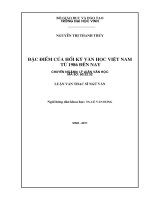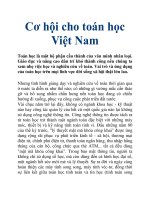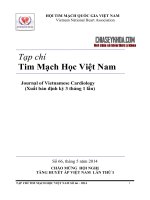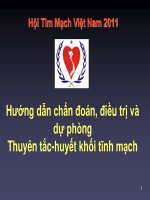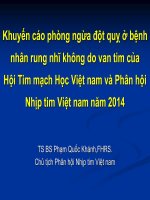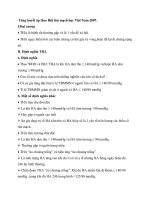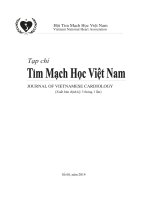Hội Tim mạch học Việt Nam New in Diabetes
Bạn đang xem bản rút gọn của tài liệu. Xem và tải ngay bản đầy đủ của tài liệu tại đây (920.22 KB, 26 trang )
Mayo Clinic Outpatient Center
CVD Risk Factor Management in
Diabetic Patients:
What's New in 2010?
Thomas G. Allison, PhD, MPH
Cardiovascular Diseases and Internal Medicine
Mayo Clinic
Rochester, MN
• Disclosures: none
• Off-label use of drugs: none
The ACCORD Trial
The trial with 3 arms but no legs to stand on
ACCORD Double 2 x 2 Factorial Design
Lipid
BP
Placebo
Fibrate
Intensive
Intensive
Glycemic
Control
1383
1374
1178
1193
5128
Standard
Glycemic
Control
1370
1391
1184
1178
5123
2765
2362
2371
10,251
2753
5518
Standard
4733*
* 94% power for 20% reduction in event rate, assuming
standard group rate of 4% / yr and 5.6 yrs follow-up
ACCORD Baseline Patient
Characteristics
Number of patients: 10,251
Age: 62 years
Duration of diabetes: 10 years
Macrovascular disease: >35 %
HbA1c: 8.1%
ACCORD-Glucose Treatment
Approach
HbA1c Target: < 6.0% versus < 7.0-7.9%
Duration of follow-up: Median 3.4 yrs
Ending therapy:
Sulfonylurea: 78% vs. 68%
Repaglinide: 50% vs. 18%
Metformin: 74% vs. 67%
Rosiglitazone: 91% vs. 58%
Exenatide: 12% vs. 4%
Insulin: 77% vs. 35%
ACCORD
Glucose control
9.0
Hba1c (%)
8.5
Standard therapy
8.0
7.5
7.0
6.5
6.0
0
Intensive therapy
0
1
2
3
4
5
6
Time (years)
ACCORD Study Group. N Engl J Med.008;358:2545-59.
ACCORD Primary outcome
(CV death, MI, stroke)
Patients with events (%)
25
20
Standard therapy
HR 0.90 (0.78-1.04)
P = 0.16
15
10
Intensive therapy
5
0
0
1
2
3
4
5
6
Time (years)
ACCORD Study Group. N Engl J Med.008;358:2545-59.
ACCORD
All-cause mortality
25
20
Patients
with events
(%)
15
Intensive therapy
HR 1.22 (1.01-1.46)
P = 0.04
10
5
Standard therapy
0
0
1
2
3
4
5
6
Time (years)
ACCORD Study Group. N Engl J Med.008;358:2545-59.
ACCORD-Blood Pressure
• N=4733 type 2 diabetics
• Systolic blood pressure goals
– < 120 mmHg versus < 140 mmHg
• Primary outcome (composite):
– Nonfatal MI / stroke / CV death
• Mean follow-up: 4.7 years
• Many drugs/combinations provided to achieve
goal BP according to randomized assignment
• Intensive Intervention:
– 2-drug therapy initiated: thiazide-type diuretic +
ACEI, ARB, or -blocker.
– Drugs added and/or titrated at each visit to achieve
SBP <120 mm Hg.
• Standard Intervention:
– Intensify therapy if SBP ≥160 mm Hg @ 1 visit or
≥140 mm Hg @ 2 consecutive visits
– Down-titration if SBP <130 mm Hg @ 1 visit or
<135 mm Hg @ 2 consecutive visits
Mean # Meds
Intensive:
Standard:
3.2
1.9
3.4
2.1
3.5
2.2
3.4
2.3
Average after 1st year: 133.5 Standard vs. 119.3 Intensive, Delta = 14.2
Primary and Secondary Outcomes
Intensive
Events
(%/yr)
Standard
Events
(%/yr)
HR (95% CI)
p
208 (1.87)
237 (2.09)
0.88 (0.73-1.06)
0.20
Total Mortality
Cardiovascular
Deaths
Nonfatal MI
150 (1.28)
144 (1.19)
1.07 (0.85-1.35)
0.55
60 (0.52)
58 (0.49)
1.06 (0.74-1.52)
0.74
126 (1.13)
146 (1.28)
0.87 (0.68-1.10)
0.25
Nonfatal Stroke
34 (0.30)
55 (0.47)
0.63 (0.41-0.96)
0.03
Total Stroke
36 (0.32)
62 (0.53)
0.59 (0.39-0.89)
0.01
Primary
ACCORD-Lipid
• N=5518 type 2 diabetics
• Open label Simvastatin + PBO or fenofibrate
• Primary outcome (composite):
– Nonfatal MI / stroke / CV death
• Mean follow-up: 4.7 years
Other Recent Negative Prevention Trials
in Diabetes
Lipid Treatment
• FIELD
– No benefit to Fenofibrate versus PBO
Blood Pressure Treatment
• INVEST
– No difference in outcomes with SBP < 130
versus 130-140 mmHg in type 2 diabetics
Glucose Management
• ADVANCE
– A1c < 6.5% using Gliclazide versus local
standard (A1c < 7.0%)
• VADT
– Intensive (A1c < 7.0%) versus standard (A1c ~
8.5%) in military veterans with type 2 DM
Perspective on ACCORD
• Was it a poorly designed or conducted trial?
• Or does it simply fit in with other recent
negative CV prevention trials?
– Mostly add-on or titration trials
– Background medical therapy is better than in
older positive trials
– More intensive intervention comes with costs
• We nearing the limits of office-based CV
prevention with drug treatment of
conventional CV risk factors. Lower is not
always better and comes at a cost.
Management of CAD in Type 2
Diabetes
5-Year Outcomes: BARI-2D Trial
Survival, Revascularization vs Medical Therapy
100
Survival (%)
• Type II diabetes
• Eval for CAD
• C angiography
2,368 pt
87.8
80
60
Revascularization
Medical therapy
40
20
P=0.97
0
PCI
stratum
Med Rx CABG Med Rx
PCI
NEJM 2009;360(24):2503-15
Event-free survival (%)
CABG
stratum
88.3
Freedom from Major Cardiovascular Events,
Revascularization vs Medical Therapy
100
77.2
80
75.9
60
40
Revascularization
Medical therapy
20
P=0.70
0
0
1
2
3
4
Years since randomization
5
BARI 2-D: PCI versus Medical
Similar Results to COURAGE Trial
BARI 2-D: CABG versus Medical
Consistent with SYNTAX Trial
Insulin Sensitization versus Insulin
Provision: BARI 2-D
Conclusions
• PCI provides no additional benefit to
optimal medical therapy as an initial
treatment strategy in Type 2 diabetics
– Similar results to COURAGE Study 2007
• Type 2 diabetics with severe CAD will
show benefit with CABG
• Optimal control of CV risk factors is
indicated for all Type 2 diabetics
